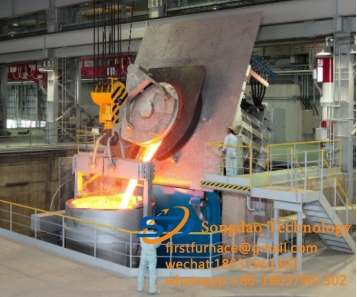- 30
- Aug
Master furnace worker, do you know the three major alarm systems for induction melting furnaces?
Master furnace worker, do you know the three major alarm systems for induction melting furnaces?
The main alarm protection systems of induction melting furnaces include water cooling alarm system, grounding protection system and overvoltage protection system. This article introduces and analyzes these three protection systems in detail.

1. Water cooling alarm system
The water cooling system is the most important auxiliary system of the induction melting furnace, which can generally be divided into two parts: the furnace body cooling system and the electrical cabinet cooling system.
The coil of the induction melting furnace body is wound by a square copper tube. Although the resistivity of copper is low, the current passing through is large, and the current in the copper tube shifts to the side of the crucible wall due to the skin effect. , Causing a large amount of heat of the copper pipe (so the insulating paint used on the surface of the copper pipe must have the ability to withstand high temperatures). In order to ensure the insulation of the furnace coil and the safety of the molten pool, sufficient cooling capacity must be guaranteed during the smelting period. And the cooling device must not be shut down before the temperature in the crucible drops to 100°C. The cooling part of the electrical cabinet is mainly used to cool the thyristors, capacitors, inductors and copper bars that will generate a lot of heat during operation. In order to achieve a good cooling effect, it is generally necessary to install an independent cooling tower outdoors. Depending on the power of the equipment, an independent furnace body and electrical cabinet cooling tower are sometimes required.
Common induction melting furnace water cooling alarm systems mainly include:
①The water temperature, pressure and flow meter installed on the water inlet pipe monitor the water inlet parameters of the water cooling system. When the water temperature exceeds the set value, the cooling tower power should be automatically increased. When the temperature exceeds the warning value or the pressure and flow are too low, an alarm and the power supply should be interrupted.
②Temperature sensors that need to be manually reset are installed in series with the outlets of the cooling water pipes of the furnace body and the electric cabinet. During maintenance, the abnormal location can be quickly determined according to the reset button of the temperature sensor.
2. Inverter system grounding alarm
During the operation of the induction melting furnace, the furnace body coil and the capacitor form a high-voltage resonance circuit. Once the ground insulation resistance is low, the high-voltage ground discharge electrode is prone to major safety accidents. To ensure the normal operation of the equipment, a ground leakage protection system must be installed.
Common ground leakage protection systems perform two functions:
1) Detect whether there are abnormal paths with low ground resistance among capacitors, furnace coils and busbars;
2) Check whether there is abnormal low resistance between the furnace body coil and the metal charge. This low resistance may be caused by metal charge infiltrating the furnace lining to cause “iron infiltration” or excessive water content in the furnace lining. Conductive debris falling into the furnace lining may also cause the resistance to decrease.
The commonly used alarm system principle is: apply a low-voltage DC power supply to the resonance circuit, and the general induction melting furnace body coils are only slightly insulated. Therefore, the applied DC voltage will be generated between the coil and the molten pool. Some small leakage currents can be detected by milliampere meter. Once the leakage current increases abnormally, it indicates that the resistance of the resonant circuit to ground decreases abnormally. The smelting furnace that uses ground leakage protection generally uses stainless steel wire at the bottom of the furnace body to be led from the furnace lining and grounded. This can ensure the zero potential of the molten pool and prevent safety accidents during the slag removal process. It can also ensure that the system can accurately detect the “iron penetration” condition.
In order to check whether the grounding alarm system is working properly at any time, a lead wire in the resonant circuit can be connected to the ground through an inductor and a contactor. By controlling the contactor to artificially create a short circuit to the ground, the sensitivity of the alarm system can be detected under the premise of ensuring safety. In order to ensure the safety of the smelting process, check whether the earth leakage alarm device of the furnace body is normal before each opening of the furnace.
3. Overcurrent and overvoltage protection
The load short-circuit of the intermediate frequency power supply or the failure of the reverse conversion current will cause the rectifier circuit to form a short-circuit current through the inverter circuit), which poses a threat to the entire rectifier and inverter thyristor, so a protection circuit must be installed.
